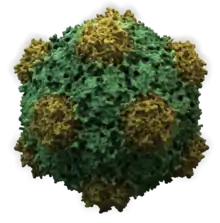Comovirus
Comovirus is a genus of viruses in the order Picornavirales, in the family Secoviridae, in the subfamily Comovirinae. Plants serve as natural hosts. There are 15 species in this genus.[1][2]
| Comovirus | |
|---|---|
 | |
| Structure of the Cowpea Mosaic Virus based on PDB 2BFU | |
| Virus classification | |
| (unranked): | Virus |
| Realm: | Riboviria |
| Kingdom: | Orthornavirae |
| Phylum: | Pisuviricota |
| Class: | Pisoniviricetes |
| Order: | Picornavirales |
| Family: | Secoviridae |
| Subfamily: | Comovirinae |
| Genus: | Comovirus |
Taxonomy
The genus contains the following species:[2]
- Andean potato mottle virus
- Bean pod mottle virus
- Bean rugose mosaic virus
- Broad bean stain virus
- Broad bean true mosaic virus
- Cowpea mosaic virus
- Cowpea severe mosaic virus
- Glycine mosaic virus
- Pea green mottle virus
- Pea mild mosaic virus
- Quail pea mosaic virus
- Radish mosaic virus
- Red clover mottle virus
- Squash mosaic virus
- Ullucus virus C
Structure
Viruses in Comovirus are non-enveloped, with icosahedral geometries, and T=pseudo3 symmetry. The diameter is around 28-30 nm. Genomes are linear and segmented, bipartite, around 24-7kb in length.[1]
| Genus | Structure | Symmetry | Capsid | Genomic arrangement | Genomic segmentation |
|---|---|---|---|---|---|
| Comovirus | Icosahedral | Pseudo T=3 | Non-enveloped | Linear | Segmented |
Life cycle
Viral replication is cytoplasmic. Entry into the host cell is achieved by penetration into the host cell. Replication follows the positive stranded RNA virus replication model. Positive stranded rna virus transcription is the method of transcription. The virus exits the host cell by tubule-guided viral movement. Plants serve as the natural host. The virus is transmitted via a vector (beetle). Transmission routes are vector and mechanical.[1]
| Genus | Host details | Tissue tropism | Entry details | Release details | Replication site | Assembly site | Transmission |
|---|---|---|---|---|---|---|---|
| Comovirus | Plants | None | Viral movement; mechanical inoculation | Viral movement | Cytoplasm | Cytoplasm | Mechanical inoculation: beetles |
References
- "Viral Zone". ExPASy. Retrieved 15 June 2015.
- "Virus Taxonomy: 2020 Release". International Committee on Taxonomy of Viruses (ICTV). March 2021. Retrieved 21 May 2021.